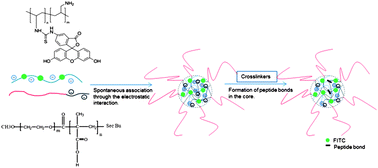Complex coacervate core micelles as diffusional nanoprobes†
Abstract
Because of their ease of preparation and versatile modification opportunities, complex coacervate core micelles (C3Ms) may be a good alternative for expensive diffusional probes, such as dendrimers. However, C3Ms are unstable at high salt concentrations and may fall apart in contact with other polymers or (solid) materials. Therefore, we designed and characterized small (15 nm radius), stable fluorescent C3Ms. These were formed by electrostatic interactions between poly(ethylene oxide-methacrylic acid) (PEO–PMAA) and fluorescently labelled poly(allylamine hydrochloride) (PAH) and irreversible cross-linking of the core through amide bonds. We compared the properties of the cross-linked and non-cross-linked micelles. The radii of the two types of micelles were quite similar and independent of the ionic strength. Surprisingly, both were found to be stable at salt concentrations as high as 1.5 M. However, unlike the non-cross-linked C3Ms, the stability of the cross-linked C3Ms is independent of the pH. As a first example of their application as diffusional nanoprobes, we present results on the diffusion of the fluorescent micelles measured in xanthan solutions using fluorescence recovery after photobleaching (FRAP).


 Please wait while we load your content...
Please wait while we load your content...